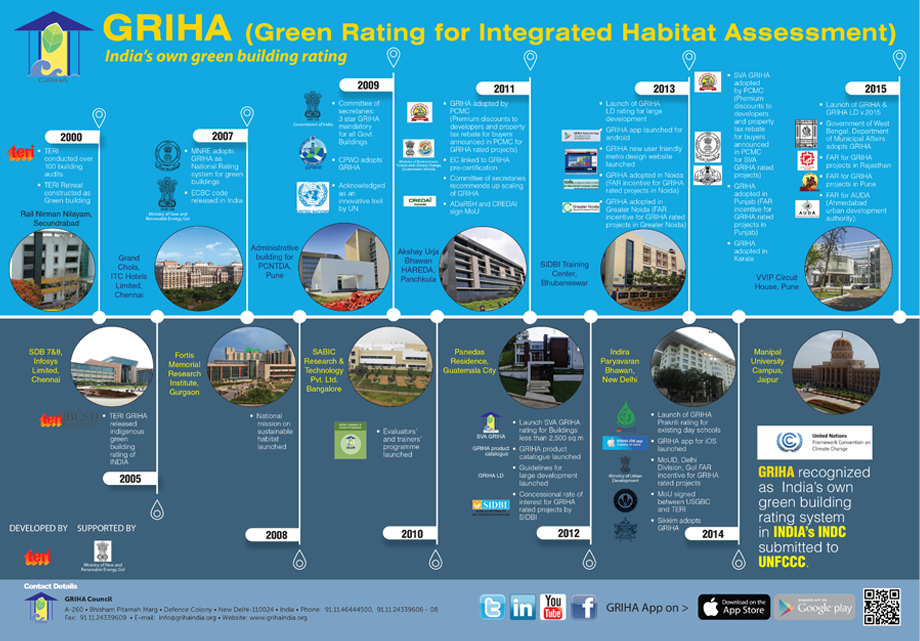About Us
Introduction
GRIHA is an acronym for Green Rating for Integrated Habitat Assessment. GRIHA is a Sanskrit word meaning – ‘Abode’. Human Habitats (buildings) interact with the environment in various ways. Throughout their life cycles, from construction to operation and then demolition, they consume resources in the form of energy, water, materials, etc. and emit wastes either directly in the form of municipal wastes or indirectly as emissions from electricity generation. GRIHA attempts to minimize a building’s resource consumption, waste generation, and overall ecological impact to within certain nationally acceptable limits / benchmarks.
Going by the old adage ‘what gets measured, gets managed’, GRIHA attempts to quantify aspects such as energy consumption, waste generation, renewable energy adoption, etc. so as to manage, control and reduce the same to the best possible extent.
GRIHA is a rating tool that helps people assesses the performance of their building against certain nationally acceptable benchmarks. It evaluates the environmental performance of a building holistically over its entire life cycle, thereby providing a definitive standard for what constitutes a ‘green building’. The rating system, based on accepted energy and environmental principles, will seek to strike a balance between the established practices and emerging concepts, both national and international.
Our Vision
We, at GRIHA Council, stand for credibility, integrity and inclusiveness, while upholding Indian ethos for future-ready and sustainable habitat.
Evolution of GRIHA
The rapid increase in Indian population and growth of Gross Domestic Product (GDP) has given rise to an enormous demand for buildings with a subsequent pressure on availability of resources. Another key challenge for the built-environment of Indian cities is the diminishing availability of water for urban areas.
In order to be sustainable, the environmental pressures of increased demand for resources coupled with a rapidly changing climate are being addressed by policy makers at various levels. Several policy and regulatory mechanisms to address the urban challenges, implemented through national plans and programmes have been devised. The Ministries and agencies at the Centre have designed frameworks such as the Environmental Clearance to ensure efficiency in resource use for large projects (i.e. more than 20,000 sq m built up area), the Energy Conservation Building Code (ECBC) applicable to air conditioned commercial buildings with connected load more than 100 kW and the Solar Buildings Programme for Energy Efficient Buildings, for implementation by the designated State agencies and municipal bodies.
However as in most countries, there is a huge scope to optimize the effectiveness of policy by encouraging a more holistic life-cycle approach to building. Lack of disincentives for non-compliance, agencies and systems working in factions (i.e. various departments at Centre and State looking at issues related to energy efficiency, renewable energy, water resources, waste management independently; as opposed to a holistic approach that would address the building sector encompassing water, energy etc. as a whole); and implementation of codes and standards prior to verification on site, leading to implementation challenges on site are some of the difficulties faced during implementation of policies on sustainable habitats.
In view of the above, and with an overall objective to reduce resource consumption, reduce greenhouse gas emissions and enhance the use of renewable and recycled resources by the building sector, TERI has played a crucial role in convergence of various initiatives, essential for effective implementation and mainstreaming of sustainable habitats in India. With over two decades of experience on green and energy efficient buildings, TERI has developed GRIHA (Green Rating for Integrated Habitat Assessment), which was adopted as the national rating system for green buildings by the Government of India in 2007 (refer figure 1).
Internationally, voluntary building rating systems have been instrumental in raising awareness and popularizing green design. However, most of the rating systems devised have been tailored to suit the building industry of the country where they were developed.
This tool has been adopted by the Ministry of New and Renewable Energy. This tool, by its qualitative and quantitative assessment criteria, is able to ‘rate’ a building on the degree of its 'greenness'.

The basic features of GRIHA
The system has been developed to help 'design and evaluate' new buildings (buildings that are still at the inception stages). A building is assessed based on its predicted performance over its entire life cycle – inception through operation. The stages of the life cycle that have been identified for evaluation are:
- Pre-construction stage: (intra- and inter-site issues like proximity to public transport, type of soil, kind of land, where the property is located, the flora and fauna on the land before construction activity starts, the natural landscape and land features).
- Building planning and construction stages: (issues of resource conservation and reduction in resource demand, resource utilization efficiency, resource recovery and reuse, and provisions for occupant health and well-being). The prime resources that are considered in this section are land, water, energy, air, and green cover.
- Building operation and maintenance stage: (issues of operation and maintenance of building systems and processes, monitoring and recording of energy consumption, and occupant health and well-being, and also issues that affect the global and local environment).
The benefits
On a broader scale, this system, along with the activities and processes that lead up to it, will benefit the community at large with the improvement in the environment by reducing GHG (greenhouse gas) emissions, reducing energy consumption and the stress on natural resources.
Some of the benefits of a green design to a building owner, user, and the society as a whole are as follows:
- Reduced energy consumption without sacrificing the comfort levels
- Reduced destruction of natural areas, habitats, and biodiversity, and reduced soil loss from erosion etc.
- Reduced air and water pollution (with direct health benefits)
- Reduced water consumption
- Limited waste generation due to recycling and reuse
- Reduced pollution loads
- Increased user productivity
- Enhanced image and marketability